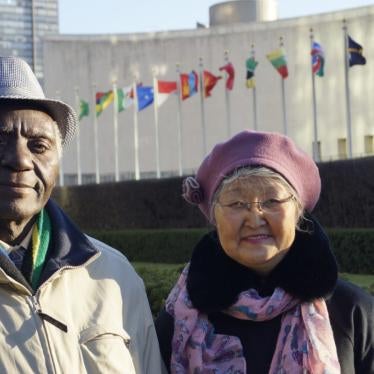The most troubling correctional development in recent decades may be the stunning expansion in the use of prolonged administrative segregation (AS), typically in super maximum security facilities. Unfortunately, Eighth Amendment litigation has been of little help for inmates enduring the harsh AS conditions of isolation and reduced opportunities for sensory stimulation and purposeful activities. Even when faced with contemporary and historical evidence that prolonged isolation can lead to serious psychological disturbances in previously healthy prisoners, the courts have deferred to prison officials who insist such confinement is necessary for prison safety and security. They have also trivialized the mental suffering of many, if not most, isolated inmates. The court in Madrid v. Gomez concluded, for example, that the mental pain suffered by many inmates in the Secure Housing Unit of California's Pelican Bay State Prison did not "significantly exceed the kind of generalized psychological pain that courts have found compatible with Eighth Amendment standards."[i]
To date, the only consistent substantive bright spot in supermax litigation has been the protection of prisoners whose existing or prior mental illness puts them at high risk of serious injury to their mental health if confined in AS. In class action cases in at least fourteen states, federal courts have either issued decisions or accepted settlements that prohibit or sharply limit prison officials' ability to place or keep mentally ill prisoners in isolated confinement.[ii]
Given the cramped and unfriendly Eighth Amendment jurisprudence and the limited prospects for success challenging AS, it is little wonder that some prisoner rights lawyers and their psychiatric experts responded with angry concern to the publication of the results of research on the psychological effects of one year of confinement at Colorado's supermax prison, Colorado State Penitentiary (CSP).[iii] They fear the research, which showed scant adverse psychological impact from CSP confinement, might undercut their efforts to reform and reduce the use of AS. (See Meztner and O'Keefe for description of research and results.)[iv] As someone who has long criticized the US penchant for supermax prisons and has wished US courts would acknowledge how easily the pursuit of safety and security can slide into cruelty, I am nonetheless not as dismayed by the study as are some. The study does not legitimize AS, either at CSP or elsewhere, and it certainly does not obviate human rights-based criticisms.
Before limning some of the reasons for my belief the study should not frustrate supermax reform efforts, I want to address doubts that may exist about the study's integrity. I was one of three outside members of the nine person advisory committee for the study; the other six were officials with the Colorado Department of Corrections. The committee communicated and met frequently from the very beginning of the project through its conclusion. Our discussions were extensive, open and no holds-barred. The principal researchers (the head of research at the Colorado Department of Corrections and a professor in the Department of Psychology of the University of Colorado) did their best to develop a sound research protocol that would overcome some of the problems with prior studies and that would permit a scientifically valid measurement of the psychological impact of a year's confinement at CSP-a difficult enterprise at best. If there are methodological flaws in the study, they do not reflect any effort by the researchers or the Colorado Department of Corrections to skew the results.
I leave it to others to debate whether the Colorado study used the best methodology to test its hypotheses, whether there are feasible alternative methodologies that might have better captured the study participants' psychological symptoms and trajectory, and whether such alternatives would have led to different results. (If the Colorado study had found serious psychological deterioration among CSP inmates, it would no doubt have been met with criticism, but presumably from different quarters.) Without dismissing concern about the methodology, the research results are worth considering on their own terms. What does the study say-and what doesn't it say-about supermax confinement?
First, it is important to emphasize that the Colorado research did not seek to determine whether prolonged AS is necessary, whether other non-isolation based approaches to difficult or dangerous inmates might be equally if not more effective in terms of prison safety or security, or whether the specific conditions at CSP are consistent with the Eighth Amendment or human rights. It focused solely on psychological impact. I should also add that I do not endorse the actual conditions at CSP, how it is used, who is confined there (particularly the inclusion of mentally ill inmates), why, and for how long. Much of the criticism I have levied elsewhere against supermax prisons applies to CSP.[v]
Impact on Non-mentally Ill
Turning to psychological impact, let us consider first the research finding that inmates who were included in the "non-mentally ill" group at CSP did not have a downward psychological trajectory. It would be a mistake to interpret this finding as proof AS does not harm healthy inmates. The study revealed that these inmates (like those diagnosed as mentally ill) were already highly symptomatic at the start of the study when they were sent to CSP, as revealed by their initial scores on multiple psychological and cognitive measures. Indeed, many already displayed "SHU syndrome" symptoms. (The study did not examine why they had those symptoms, e.g., did they develop them while in segregation prior to assignment to CSP? Did they enter prison with them?) For the most part the inmates retained elevated symptoms throughout the study. If the study had assessed the impact of one year's segregation on inmates who did not already have such symptoms, the results might well have been different. Other distinctive features of the study participants also limit the extent to which the findings can be generalized. For example, inmates who were illiterate were excluded, and people who cannot read and write may find segregation much harder to tolerate than others.
While all supermax prisons impose misery, each imposes its own version. The basic confinement model is the same-23 to 24 hours a day of solitary in-cell confinement (although double celling exists in some segregation units), as well as extensive security measures and surveillance. But there are significant differences in the physical conditions, privileges and programs at different facilities and the Colorado study raises the question of whether those differences might affect psychological impact.
CSP has a combination of features that was not present in the supermax prisons where experts concluded the conditions produced psychological deterioration among prisoners who had not previously been mentally ill. For example, the CSP cells have windows to the outside, the cell doors have windows through which prisoners can manage to see each other (and they apparently communicate in sign language), all prisoners except those at the lowest level of privileges have access to radio and television and can participate in educational and skills-enhancing programming, they have some access to telephone and visits, they can get books, newspapers, magazines, art supplies and games, and there does not appear to be the arbitrary and excessive use of force that creates a climate of tension and fear such as existed at Pelican Bay. Prisoners who follow the rules and engage in the requisite programs progress through CSP's "quality of life" level system and most have a realistic prospect of getting back to general population (if they are not discharged or released to parole first).[vi]
In light of the Colorado study and in the absence of research on differences between supermax prisons, it is at least worth speculating whether CSP's particular version of supermax confinement may be less psychologically damaging than others. Supermax facilities that differ from CSP remain as vulnerable as before to charges they cause inmates to psychologically deteriorate.
Impact on Mentally Ill
What about prisoners who had diagnoses of mental illness when they were sent to CSP? The study indicates that overall 7% worsened, 20% improved, and the rest remained essentially unchanged over the course of the study. It is unfortunate that the study lacked the data to tell us the total length of time the CSP participants spent at the different quality of life levels. It is reasonable to assume that those who spent the most time at level one (the harshest) were more symptomatic and may have shown more signs of deterioration than those who progressed to and spent more time at the higher levels.
The study captures symptoms reported at specific testing intervals, and does not reflect discrete episodes of distress that may have occurred and ended between testing. Apart from the self reported symptoms, DOC clinicians documented twenty-two self-harming ideation or behavior "crisis" events for ten of the mentally ill CSP study participants over the research year (one inmate accounted for one-third of those events) and eleven of them had episodes of psychotic symptoms (one inmate accounted for half of those episodes), but the study does not indicate the precise nature, severity and duration of those episodes, nor does it indicate whether the inmates had similar crises prior to CSP confinement.[vii]
That some already ill prisoners got worse at CSP will not surprise anyone familiar with prolonged administrative segregation. The small proportion who deteriorated may reflect the fact that relatively few of the mentally ill study participants at CSP had been designated by Department of Corrections clinical staff as having high mental health needs.[viii] The CSP results might have been different if the CSP study group had included more acutely ill inmates.
Corrections officials should not take heart that some mentally ill inmates improved in segregation. It is well known that many mentally ill inmates find general population extremely stressful and have a difficult time coping (which can lead to the misconduct that lands them in AS in the first place). Solitary in-cell confinement may offer something of a refuge for them. But the housing alternatives for the mentally ill should not be general population or segregation. If inmates with serious mental health problems are going to be confined in prison, officials need to create facilities designed and staffed to respond to their unique needs and vulnerabilities. Operated to promote prison safety primarily through isolation and deprivation, supermax prisons are counter-therapeutic. Inmates with mental illness at CSP who improved during the study nevertheless remained symptomatic. "Improve," of course, is a relative term.
Most important, the fact that 70 percent of the mentally ill study participants at CSP remained unchanged over the course of the study year is striking evidence that CSP is no place for the mentally ill. Staying the same means remaining mentally ill-highly symptomatic, illness unabated. The study does not attempt to determine if the absence of improvement is the result of the conditions of confinement, the nature, quantity and quality of mental health services provided to CSP inmates, or both. But the bottom line is that the preponderance of mentally ill inmates at CSP do not get better.
The Human Rights Perspective
There are hermits who happily shun human contact. Most of us, however, are social beings who require meaningful interaction with others to be fully human. As humans, we also need contact with the natural world, sensory and intellectual stimulation, and the opportunity to engage in purposeful activities. Unfortunately, under current Eighth Amendment case law, prisoners "deserve" no more than the minimum civilized necessities-i.e., food, shelter, warmth, sanitation, and medical care. The fact that living in segregation cut off from other people and the natural world can cause utter misery, that it can be an experience akin to "living in a tomb," is of little constitutional moment absent the creation or exacerbation of mental illness.[ix]
Grounded in humanistic principles, the human rights assessment of prolonged segregation is far more critical. The starting point is international human rights treaties. Under the International Covenant on Civil and Political Rights, corrections officials have a positive obligation to respect the humanity and inherent dignity of all prison inmates, even those deemed dangerous and difficult, and the primary purpose of incarceration must be the "reformation and social rehabilitation" of inmates.[x] Human rights treaties also prohibit officials from subjecting inmates to torture or other cruel, inhuman or degrading punishment or treatment.[xi]
Although corrections professionals do not like the term, human rights authorities consider administrative segregation to be a form of solitary confinement, in recognition of the fact that its defining feature is in-cell confinement that isolates inmates from each other and staff. Solitary confinement does not automatically violate human rights: the human rights assessment depends on the specific conditions, the justification for them, their duration and the vulnerabilities and needs of individual prisoners. For example, harsh conditions of isolation which are acceptable for a month may be cruel when imposed for years. Denying a mentally ill inmate access to valuable out-of-cell therapeutic interventions for a week may be tolerable, but may become inhumane when the denial persists for months. Existing human rights jurisprudence leaves little doubt that prolonged supermax confinement in the United States cannot be squared with respect for inmates' humanity. It can also violate the prohibition on cruel, inhuman or degrading treatment, and, depending on the specific circumstances, may even amount to torture.[xii]
While human rights authorities recognize that solitary confinement can lead to psychological deterioration, the creation or exacerbation of mental illness is not a prerequisite for a human rights violation. Deep emotional pain suffices. There may be no way to measure empirically the misery produced by prolonged supermax confinement, but there is abundant testimony to the suffering many isolated inmates endure.[xiii] Even if, as the Colorado study suggests, CSP does not cause inmates confined there to psychologically deteriorate, that does not mean it passes muster under human rights law. Because solitary confinement can be so painful-and can be literally unendurable (witness the high rate of suicide in segregation)-and because it too often fails to respect inmates' basic human dignity, human rights authorities are unanimous that it should an exceptional measure imposed only when necessary, only for so long as necessary and with the specific conditions entailing no more deprivation than is necessary. Even when solitary confinement is imposed consistent with these criteria, increased opportunities for social interaction-be it with staff, other inmates or other people-should be provided to mitigate the impact of isolation. There is widespread agreement that prisoners with serious mental illness should never be subjected to solitary confinement. Finally, if legitimate considerations of prison safety and security mandate extended periods of solitary confinement, the conditions must be modified to even further ameliorate the isolation and to recognize the humanity of the person so confined.[xiv]
US courts to date have not incorporated the human rights framework into their jurisprudence. But corrections officials should not wait for courts to tell them what to do. They remain obligated under treaties to which the United States is a party to protect and respect the human rights of prisoners. I would hope the Colorado study spurs considerable reflection and policy changes both in the Colorado DOC and elsewhere.
[i] Madrid v. Gomez, 889 f. Supp. 1146, 1265 (N.D. CA 1995).
[ii] Over the years, class action litigation in federal courts has prohibited or substantially limited or changed conditions of segregation confinement for mentally ill inmates in Alabama, Arizona, California, Connecticut, Florida, Indiana, Michigan, Mississippi, New Jersey, New Mexico, New York, Ohio, Wisconsin, and Texas.
[iii] O'Keefe ML, Klebe KJ, Stucker A, Sturm K, Leggett W. One Year Longitudinal Study of the Psychological Effects of Administrative Segregation. Funded by and submitted to the National Institute of Justice, Office of Justice Programs, U.S. Department of Justice, October 31, 2010.
[iv] Metzner JL and O'Keefe ML. Psychological Effects of Administrative Segregation: The Colorado Study, Correctional Mental Health Newsletter 2011 .
[v] Fellner J. Out of Sight: Super-Maximum Security Confinement in the United States. Human Rights Watch, 2000, available at https://www.hrw.org/en/reports/2000/02/01/out-sight-super-maximum-securit... Fellner, J. Afterwords: A Few Reflections. Criminal Justice and Behavior 35:1079-1087, 2008. Fellner J and Mariner J. Cold Storage: Super-Maximum Security Confinement in Indiana. Human Rights Watch, 1997, available at https://www.hrw.org/en/reports/1997/10/01/cold-storage.
[vi] Needless to say, there is much to criticize about CSP, starting with, of course, the fact that mentally ill inmates are confined there. Other notable objectionable features include the fact that there is no outdoor recreation. Inmates have "recreation" in an empty indoor cell on the tier which has open vents to let in fresh air. Inmates are escorted in full restraints to and from the recreation cell.
[vii] There may have been incidents of self-harming behavior/ideation or psychotic symptoms that occurred without staff's knowledge and therefore are not included in the reported events.
[viii] The Colorado Department of Correction uses a five level mental health classification system, with higher numbers corresponding to higher mental health needs. Inmates at level 3 are deemed to need mental health services. Most (70%) of the CSP mentally ill study participants were at level 3, 17% were at levels 4 and 5.
[ix] See, e.g., Fellner J and Mariner J. Cold Storage: Super-Maximum Security Confinement in Indiana. Human Rights Watch, 1997, available at https://www.hrw.org/en/reports/1997/10/01/cold-storage.
[x] Article 10, International Covenant on Civil and Political Rights.
[xi] Article 7, International Covenant on Civil and Political Rights. Convention against Torture and Other Cruel, Inhuman or Degrading Treatment or Punishment.
[xii] E.g., United Nations Human Rights Committee, General Comment 20, Article 7, Compilation of General Comments and General Recommendations Adopted by Human Rights Treaty Bodies, U.N. Doc. HRI/GEN/1/Rev.1 at 30 (1994), para. 6.; United Nations Human Rights Committee: Consideration of reports submitted by States parties under Article 40 of the Covenant, concluding observations of the Human Rights Committee, United States of America. New York: UNHRC, UN Doc. CCPR/C/USA/CO/3, 2006; United Nations Committee Against Torture: Consideration of reports submitted by States parties under Article 19 of the Convention, Conclusions and Recommendations of the Committee Against Torture, United States of America. New York: UN Committee Against Torture, UN Doc. CAT/C/USA/CO/2, 2006; Interim Report of the UN Special Rapporteur on Torture and Other Cruel, Inhuman or Degrading Treatment or Punishment. UN General Assembly. New York: United Nations, UN Doc. A/63/ 175:18-21, 2008.
[xiii] Reyes H: The worst scars are in the mind: psychological torture. International Review of the Red Cross 89:591-617, 2007.
[xiv] In addition to sources cited above, see generally, Rodley NS and Pollard M. The Treatment of Prisoners under International Law, 3rd Ed., Oxford U. Press 2009; Nowak M. and McArthur E. The United Nations Convention against Torture: A Commentary, Oxford University Press, 2009; Shalev S. Sourcebook on Solitary Confinement, Mannheim Centre for Criminology, London School of Economics and Political Science, 2008, available at http://solitaryconfinement.org/uploads/sourcebook_web.pdf; The Istanbul Statement on the Use and Effects of Solitary Confinement, Adopted at the International Psychological Trauma Symposium 2007, available at http://www.solitaryconfinement.org/uploads/Istanbul_expert_statement_on_sc.pdf.








